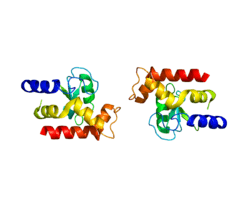ARFGAP1
ADP-ribosylation factor GTPase-activating protein 1 is an enzyme that in humans is encoded by the ARFGAP1 gene.[5][6] Two transcript variants encoding different isoforms have been found for this gene.
Function
The protein encoded by this gene is a GTPase-activating protein (GAP) which associates with the Golgi apparatus and which interacts with ADP-ribosylation factor 1 (ARF1). The encoded protein promotes hydrolysis of ARF1-bound GTP and is required for the dissociation of coat proteins from Golgi-derived membranes and vesicles. Dissociation of the coat proteins is required for the fusion of these vesicles with target compartments. The activity of this protein is stimulated by phosphoinositides and inhibited by phosphatidylcholine.[6]
The protein has two amphipathic lipid packing sensor motifs, that let the protein sense the curvature of the membrane (<30 nm) or lipid packing defects, and in this way evaluate if the vesicle is mature and ready for coat disassembly.[7]
Interactions
ARFGAP1 has been shown to interact with KDELR1 and LRRK2.[8][9][10]
References
- 1 2 3 GRCh38: Ensembl release 89: ENSG00000101199 - Ensembl, May 2017
- 1 2 3 GRCm38: Ensembl release 89: ENSMUSG00000027575 - Ensembl, May 2017
- ↑ "Human PubMed Reference:".
- ↑ "Mouse PubMed Reference:".
- ↑ Huber I, Rotman M, Pick E, Makler V, Rothem L, Cukierman E, Cassel D (February 2001). "Expression, purification, and properties of ADP-ribosylation factor (ARF) GTPase activating protein-1". Methods Enzymol. 329: 307–16. doi:10.1016/S0076-6879(01)29092-2. PMID 11210549.
- 1 2 "Entrez Gene: ARFGAP1 ADP-ribosylation factor GTPase activating protein 1".
- ↑ Antonny, Bruno (June 2011). "Mechanisms of membrane curvature sensing". Annu Rev Biochem. 80: 101–123. doi:10.1146/annurev-biochem-052809-155121. PMID 21438688.
- ↑ Aoe T, Cukierman E, Lee A, Cassel D, Peters PJ, Hsu VW (December 1997). "The KDEL receptor, ERD2, regulates intracellular traffic by recruiting a GTPase-activating protein for ARF1". EMBO J. 16 (24): 7305–16. doi:10.1093/emboj/16.24.7305. PMC 1170331. PMID 9405360.
- ↑ Majoul I, Straub M, Hell SW, Duden R, Söling HD (July 2001). "KDEL-cargo regulates interactions between proteins involved in COPI vesicle traffic: measurements in living cells using FRET". Dev. Cell. 1 (1): 139–53. doi:10.1016/S1534-5807(01)00004-1. PMID 11703931.
- ↑ Stafa K, Trancikova A, Webber PJ, Glauser L, West AB, Moore DJ (February 2012). "GTPase activity and neuronal toxicity of Parkinson's disease-associated LRRK2 is regulated by ArfGAP1". PLoS Genet. 8 (2): e1002526. doi:10.1371/journal.pgen.1002526. PMC 3280333. PMID 22363216.
External links
- Human ARFGAP1 genome location and ARFGAP1 gene details page in the UCSC Genome Browser.
Further reading
- Rothman JE (1994). "Mechanisms of intracellular protein transport". Nature. 372 (6501): 55–63. doi:10.1038/372055a0. PMID 7969419.
- Bernards A, Settleman J (2005). "GAP control: regulating the regulators of small GTPases". Trends Cell Biol. 14 (7): 377–85. doi:10.1016/j.tcb.2004.05.003. PMID 15246431.
- Maruyama K, Sugano S (1994). "Oligo-capping: a simple method to replace the cap structure of eukaryotic mRNAs with oligoribonucleotides". Gene. 138 (1–2): 171–4. doi:10.1016/0378-1119(94)90802-8. PMID 8125298.
- Cukierman E, Huber I, Rotman M, Cassel D (1996). "The ARF1 GTPase-activating protein: zinc finger motif and Golgi complex localization". Science. 270 (5244): 1999–2002. doi:10.1126/science.270.5244.1999. PMID 8533093.
- Suzuki Y, Yoshitomo-Nakagawa K, Maruyama K, et al. (1997). "Construction and characterization of a full length-enriched and a 5'-end-enriched cDNA library". Gene. 200 (1–2): 149–56. doi:10.1016/S0378-1119(97)00411-3. PMID 9373149.
- Aoe T, Cukierman E, Lee A, et al. (1998). "The KDEL receptor, ERD2, regulates intracellular traffic by recruiting a GTPase-activating protein for ARF1". EMBO J. 16 (24): 7305–16. doi:10.1093/emboj/16.24.7305. PMC 1170331. PMID 9405360.
- Mossessova E, Gulbis JM, Goldberg J (1998). "Structure of the guanine nucleotide exchange factor Sec7 domain of human arno and analysis of the interaction with ARF GTPase". Cell. 92 (3): 415–23. doi:10.1016/S0092-8674(00)80933-2. PMID 9476900.
- Huber I, Cukierman E, Rotman M, et al. (1998). "Requirement for both the amino-terminal catalytic domain and a noncatalytic domain for in vivo activity of ADP-ribosylation factor GTPase-activating protein". J. Biol. Chem. 273 (38): 24786–91. doi:10.1074/jbc.273.38.24786. PMID 9733781.
- Zhang C, Yu Y, Zhang S, et al. (2000). "Characterization, chromosomal assignment, and tissue expression of a novel human gene belonging to the ARF GAP family". Genomics. 63 (3): 400–8. doi:10.1006/geno.1999.6095. PMID 10704287.
- Majoul I, Straub M, Hell SW, et al. (2001). "KDEL-cargo regulates interactions between proteins involved in COPI vesicle traffic: measurements in living cells using FRET". Dev. Cell. 1 (1): 139–53. doi:10.1016/S1534-5807(01)00004-1. PMID 11703931.
- Deloukas P, Matthews LH, Ashurst J, et al. (2002). "The DNA sequence and comparative analysis of human chromosome 20". Nature. 414 (6866): 865–71. doi:10.1038/414865a. PMID 11780052.
- Yu S, Roth MG (2003). "Casein kinase I regulates membrane binding by ARF GAP1". Mol. Biol. Cell. 13 (8): 2559–70. doi:10.1091/mbc.E02-04-0189. PMC 117925. PMID 12181329.
- Yang JS, Lee SY, Gao M, et al. (2002). "ARFGAP1 promotes the formation of COPI vesicles, suggesting function as a component of the coat". J. Cell Biol. 159 (1): 69–78. doi:10.1083/jcb.200206015. PMC 2173491. PMID 12379802.
- Strausberg RL, Feingold EA, Grouse LH, et al. (2003). "Generation and initial analysis of more than 15,000 full-length human and mouse cDNA sequences". Proc. Natl. Acad. Sci. U.S.A. 99 (26): 16899–903. doi:10.1073/pnas.242603899. PMC 139241. PMID 12477932.
- Ota T, Suzuki Y, Nishikawa T, et al. (2004). "Complete sequencing and characterization of 21,243 full-length human cDNAs". Nat. Genet. 36 (1): 40–5. doi:10.1038/ng1285. PMID 14702039.
- Beausoleil SA, Jedrychowski M, Schwartz D, et al. (2004). "Large-scale characterization of HeLa cell nuclear phosphoproteins". Proc. Natl. Acad. Sci. U.S.A. 101 (33): 12130–5. doi:10.1073/pnas.0404720101. PMC 514446. PMID 15302935.
- Gerhard DS, Wagner L, Feingold EA, et al. (2004). "The status, quality, and expansion of the NIH full-length cDNA project: the Mammalian Gene Collection (MGC)". Genome Res. 14 (10B): 2121–7. doi:10.1101/gr.2596504. PMC 528928. PMID 15489334.





